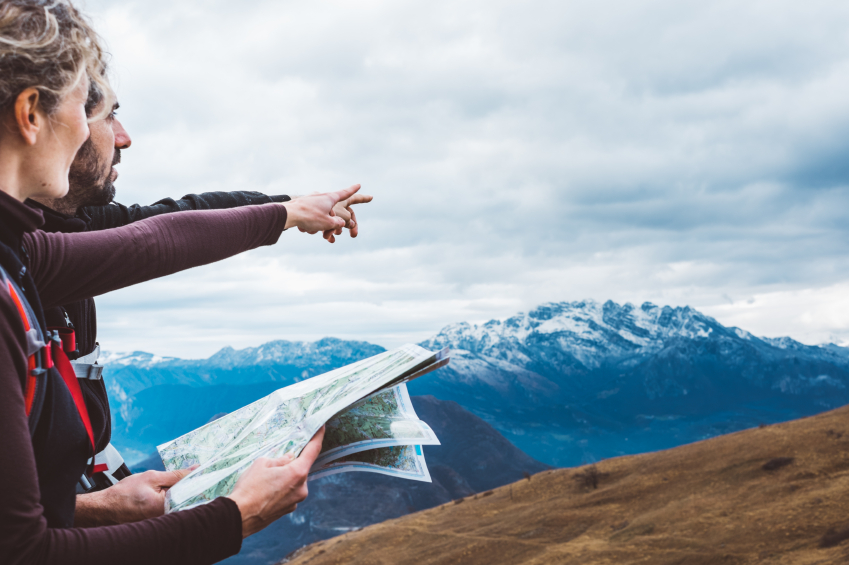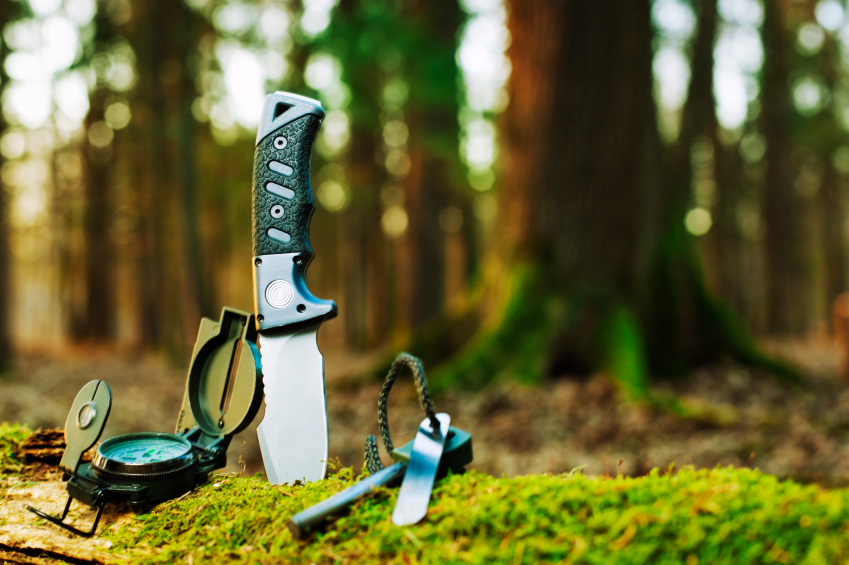
The Essential Survival Gear Checklist
Having the appropriate survival gear is an absolute essential for anyone looking to live a life of adventure. Whether you’re a regular in the wilderness, a weekend warrior or a first-time explorer, if you don’t have the right survival gear, you’re asking for trouble.
Survival kit is a tough field to navigate through though. What’s essential and what’s not? What survival gear could really save your life and what’s just an extra weight on your back when you’re hiking through the hills?
On the back of our essential outdoor survival guide, we’ve come up with a handy guide to survival gear essentials. Here’s the survival gear which one day could just save your life…
1) Survival Knife

Let’s start with the survival knife. Let’s face it; there are few things that make you feel more badass – and more like real life action man Bear Grylls – than packing a survival knife or five into your backpack and heading out into the wilderness.
A knife has so many uses that it is an absolute essential for any journey into the wild. It’s your key piece of survival gear for cutting rope, opening packages, building shelters and can even come in handy when starting fires and using first aid kits.
How to find the best survival knife for the job? Well, there are a lot out there, but what you should be looking for is durability and toughness, which means a fixed blade is often a better survival knife option than a fold-away swiss army knife – something that many people don’t know.
2) Survival Food… And The Knowledge Of How To Find A Natural Dinner

If you find yourself in a survival situation where you’re lost, alone, stranded against the odds or in significant pain or trouble, you’ll thank yourself for packing enough survival food – energy bars, high-calorie, small packaged foods that will stave off your hunger, letting you concentrate on the other pressing issues at hand.
Of course, you could argue that a survival situation only really becomes that when you’ve run out of food and have to turn to the wilderness for help. This is where your ‘survival gear’ becomes the nature around you, and if you’re not much of a hunter at this point, knowing your stuff could save your life.
The nature around you will differ depending on where you’re hiking, but even the knowledge of a couple of edible plants could save your life, so do the research and remember, if in serious need, take one of Bear Grylls‘ survival tips and eat some insects for the protein and fat. It’s one of the safest options there is!
It should go without saying at this point that if you’re not 100 percent certain that a plant is edible, you shouldn’t eat it at all. The need almost definitely does not justify the high level of risk!
3) Survival Backpack

It’s imperative that you get a good survival backpack for when you’re out on your adventures.
But what exactly do we mean by ‘survival backpack’? Well, if it can’t carry much content it isn’t a survival backpack, if it isn’t waterproof it isn’t a survival backpack, and if it doesn’t provide comfort or ends up hurting your posture or lower back, it certainly isn’t a survival backpack either.
If any of the listed applies to your current carrier, ditch it and get a proper rucksack that ticks all the boxes, otherwise your bag will end up causing more problems than it solves.
4) First Aid Kit

Carrying a first aid kit can turn an absolute abundance of potential survival emergencies into comparatively minor setbacks. If you’re not bringing a first aid kit out with you on your travels, you’re not giving enough respect to the wilderness around you.
From blood wounds to potential infections, a first aid kit is an essential for turning a survival situation into an inconvenience, and that could be a difference that saves your life. Arguably the most essential piece of survival gear at your disposal.
5) Rope/Cord

Rope may not be an essential for camping, but it is incredibly useful, and if you find yourself in a situation where you need to construct a survival shelter, it may just be the piece of survival gear that ends up saving your life.
Parachute chord can be a favourite with many more experienced adventurers due to the strength, flexibility and light weight of it, as well as the fact that when packed properly it takes up very little space.
Carrying chord gives you the means for repairs should you have any shelter issues, need to repair a tent, find yourself in a climbing situation or even if things get really bad and you need to lay a trap and hunt your dinner.
6) A Tarp

If you’ve got rope, cord and you’ve got a tarp, then you’ve almost definitely got a shelter for the night no matter what kind of terrain you’re travelling through.
All you’ll need is a few branches or something to prop up at least one end of your tarp on and you’ve got a shelter from that pelting rain outside, one of the most important things you can do when you are in a survival situation. It’s simple, it’s easy to carry, and it could save you a hell of a lot of time, warmth and energy when all of those things are running low.
A brilliant piece of survival kit that you’ll thank yourself for bringing come 4am in wild rain.
7) Survival Bag or Survival Blanket

You know those blankets or bags you’ve seen people end up in at music festivals after getting absolutely hammered and rolling around naked in mud for three-hours, becoming an internet sensation and a family disgrace simultaneously as the resulting seven-second video goes viral around the globe? Yeah, those blankets could actually save your life.
If you’re stranded in isolation or waiting for pick up after an injury and the conditions are against you, this is the piece of survival kit that’ll give you shelter from the elements and help you maintain your bodily heat and energy when it matters most of all.
As soon as you stop walking, you start losing heat, and if you lose too much you could get hypothermia. A survival bag will at best save you, at worst slow the process, and seeing as it folds up to the size of a pack of cards, you’d be stupid not to put it on your shopping list when you’re getting your survival gear.
8) Water Bottle

One of the most important things for anyone heading out on an extensive adventure, the water bottle is also one of the most commonly forgotten things by the everyday explorer – simply because it’s often attached last.
So, if there’s one survival tip that you really take away from this article, it’s this; remember your water bottle! It’s about as essential as essential survival gear gets.
There’s no true substitute for a water bottle. Water sacks are tougher to fill and easier to puncture. Get yourself a strong bottle and fix it to your survival backpack. It could be the most important thing you ever do!
9) Survival Whistle & Other Signalling Devices

Think whistles are just for kids to annoy their parents with? Well, let us remind you how Rose signalled for help and ended up surviving after the tragic death of Jack in ‘Titantic’ – WITH A WHISTLE. Enough said?
Seriously though, a whistle is so lightweight, so small and easy to pack, and so, so important in a survival situation. If you have a bone break and can’t walk, if you have a bad wound or are in need of any kind of immediate assistance and your phone is out of signal, a sharp blow on a whistle can be the simplest and easiest way to attract attention and save your life.
It can also be useful to pack a signalling survival mirror, which often come with descriptions of how to use and flash SOS, something particularly useful is you’re in an isolated scenario with no other explorers likely to come your way.
Failing that, spark up a fire and let it smoke – chances are, it’ll attract attention and you’ll have help a whole lot quicker than you would have otherwise.
10) Compass

You know that thing you’re wanderlust-driven mate has tattooed on his/her neck? Yeah, it’s called a compass, and it can actually be an incredibly useful piece of survival kit if you know how to use it.
We should highlight at this point that you will need an actual real life compass rather than one that’s just inked on to save you, but you can pick them up cheap, don’t worry. If you’re heading out on any serious adventure into the wilderness and you don’t have a compass and a map of the area, you’re putting yourself at a survival disadvantage almost immediately after leaving your house.
Learn how to read a map and use a compass and you’ll be able to navigate your way around no bother at all. A classic piece of survival gear, and one that’s stood the test of time for a very good reason.
You May Also Like
Essential Outdoor Survival Guide – Everything You Need To Know
17 Disgusting Things Bear Grylls Has Done That No Human Being Should Ever Have To Do